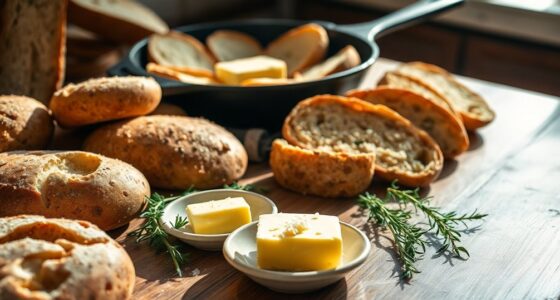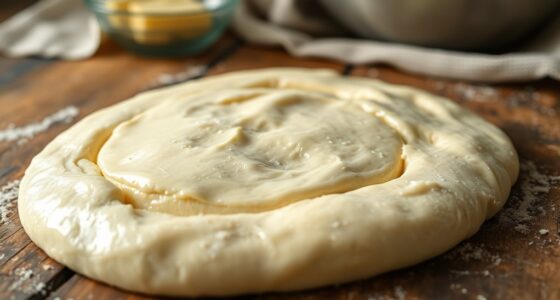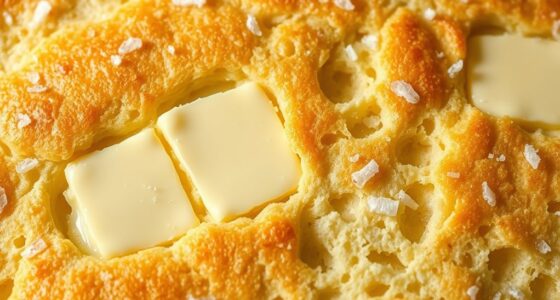To master sourdough brioche with a butter-rich crumb, focus on selecting high-quality ingredients, especially organic unbleached flour and fresh butter. Incorporate butter gradually, ensuring thorough mixing for a tender, flavorful texture. Use proper fermentation techniques like autolyse and vigilant proofing to develop complex flavors. Bake at the right temperature, use steam, and monitor your crust for even, golden color. Keep practicing these steps, and you’ll discover the secrets to that perfect, buttery loaf.
Key Takeaways
- Incorporate high-quality, softened butter thoroughly into the dough to enhance richness, flavor, and crumb tenderness.
- Use proper fermentation techniques, including autolyse and maintaining an active sourdough starter, for optimal flavor development.
- Bake at precise temperatures with steam and proper oven placement to ensure even browning and a golden, crusty exterior.
- Add infusions like vanilla or citrus zest into melted butter before mixing to enhance aroma and flavor complexity.
- Rotate and tent the bread during baking to prevent uneven coloring and achieve a beautifully even, butter-rich crust.
Understanding the Fundamentals of Sourdough and Brioche

Have you ever wondered what makes sourdough and brioche so unique? Their historical origins reveal distinct stories: sourdough dates back thousands of years as a natural fermentation method, while brioche originated in France as a rich, buttery bread. These breads differ greatly in flavor pairing; sourdough’s tangy, complex profile complements hearty dishes, whereas brioche’s sweet, buttery taste pairs beautifully with breakfast or dessert. Understanding these fundamentals helps you appreciate their differences and similarities. Sourdough relies on wild yeast and bacteria, creating a distinctive flavor, while brioche’s high egg and butter content results in a tender, rich crumb. Recognizing these origins and flavor profiles allows you to select the right bread for any occasion and enhances your baking mastery. Additionally, the role of fermentation is crucial in developing the unique textures and flavors characteristic of both breads.
Selecting and Preparing Your Ingredients for Perfect Fermentation

Choosing the right ingredients is essential for achieving ideal fermentation in your sourdough and brioche. Start with quality ingredient sourcing—use organic, unbleached flour for better flavor and fermentation activity. Fresh, unpasteurized ingredients will yield more robust and consistent results. When selecting your starter, ensure it’s active and healthy; this foundation impacts the dough’s rise and flavor development. Prepare your ingredients by measuring precisely and warming liquids to optimal temperatures to promote yeast activity. Pay attention to flavor pairing; balancing the richness of butter with the tang of sourdough enhances complexity. Properly prepared ingredients create a lively environment for fermentation, resulting in a flavorful, airy crumb. Avoid shortcuts like stale flour or cold liquids, which can hinder fermentation and compromise your bread’s texture.
Crafting the Sourdough Starter and Autolyse Process
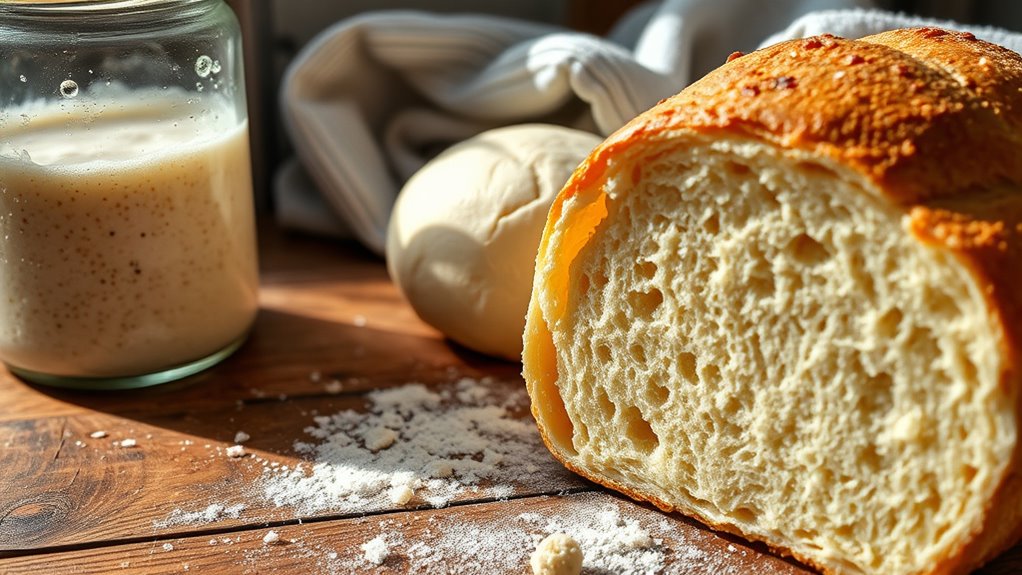
To create a strong sourdough starter, you’ll need to mix equal parts flour and water and allow the mixture to ferment at room temperature, feeding it regularly to cultivate wild yeast and beneficial bacteria. Proper starter maintenance involves maintaining ideal hydration levels—usually around 75%—to encourage activity. Here’s what to consider:
- Feeding schedule: Feed the starter daily or every 12 hours to keep it active.
- Hydration consistency: Adjust water to flour ratio for the right dough texture.
- Container choice: Use a transparent jar for easy monitoring.
- Autolyse process: Mix flour and water and let it rest before kneading, enhancing gluten development and flavor.
- Participation in remote hackathons can also inspire innovative techniques or tools for sourdough baking.
Regular maintenance and attention to hydration are key to a lively, reliable starter.
Incorporating Butter for a Luxurious, Crumbly Texture

After establishing a lively sourdough starter and perfecting the autolyse process, the next step is to incorporate butter to achieve a rich, crumbly texture. Use high-quality, softened butter, mixing it thoroughly into the dough until fully integrated. If you’re interested in dairy-free options, consider butter alternatives like margarine or coconut oil, but note they can influence the texture and flavor. To add complexity, try flavor infusions—such as a touch of vanilla, citrus zest, or herbs—mixed into the butter before incorporating. These infusions enhance the aroma and taste, elevating your brioche. Be mindful not to overmix once the butter is added to preserve the dough’s delicate crumb structure. This step guarantees your bread will be luxuriously tender and richly flavored. Additionally, understanding the importance of dough handling techniques can help maintain the integrity of the crumb and overall texture.
Techniques for Proper Kneading and Folding to Develop Gluten Structure

Developing a strong gluten network is essential for a light, airy sourdough brioche, and mastering kneading and folding techniques is key to achieving this. Proper handling enhances dough elasticity and builds a resilient gluten network. To do this effectively:
- Knead gently but thoroughly to stretch and align gluten strands.
- Perform stretch and fold at intervals to strengthen the gluten network without overworking the dough.
- Use a bench scraper to maintain tension, ensuring even gluten development.
- Observe dough elasticity—it should be smooth, elastic, and slightly tacky without tearing.
Consistent technique ensures the dough develops the ideal gluten structure, resulting in a brioche with a tender crumb and perfect rise. Proper kneading and folding are your tools for a bakery-quality loaf.
Fermentation and Proofing for Optimal Flavor and Texture
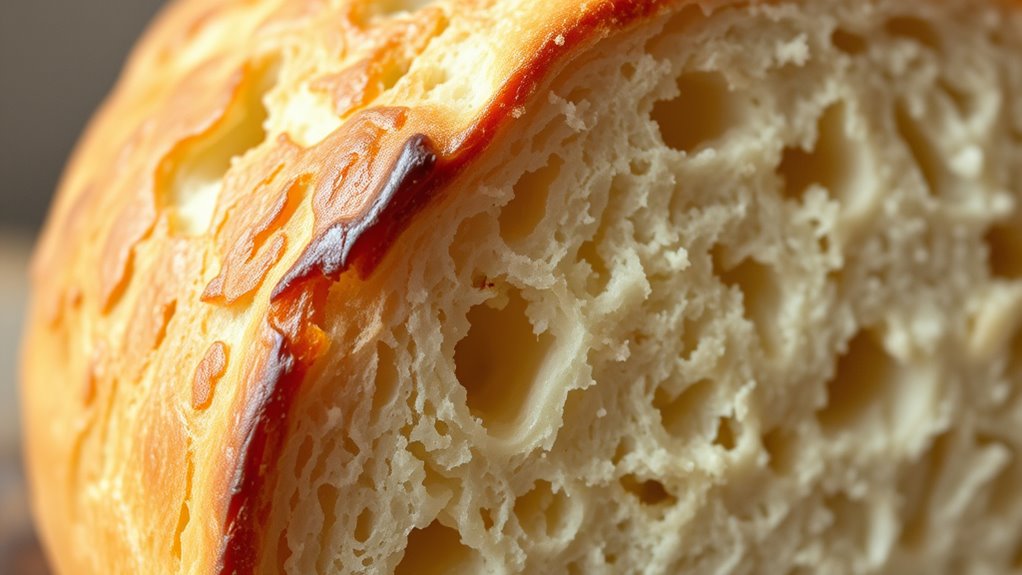
Fermentation and proofing are vital steps that shape the flavor, texture, and overall quality of your sourdough brioche. During fermentation, the dough develops complex flavors through the activity of wild yeast and bacteria, leading to a richer, more nuanced taste. Proper proofing guarantees the dough rises adequately, which is essential for texture development—creating a light, airy crumb with a tender bite. Over-proofing can cause the dough to collapse, while under-proofing results in a dense consistency. Pay attention to your dough’s size and surface feel to determine ideal proofing. Controlling fermentation time and temperature enhances flavor and guarantees a uniform, refined texture. Mastering these steps allows you to produce brioche that’s both flavorful and perfectly tender.
Baking Tips to Achieve a Golden Crust and Butter-Infused Interior

To get that beautiful golden crust, you need to pay attention to your oven temperature and baking steam. Even browning comes from consistent heat and proper dough placement, so consider using a baking stone or Dutch oven. For a rich, butter-infused interior, make sure to incorporate enough butter and bake at the right time to preserve its flavor and moisture.
Achieving Perfect Crust
Achieving a beautiful, golden crust on your sourdough brioche starts with understanding how heat and moisture interact during baking. To enhance crust quality, consider these key tips:
- Use high heat initially to promote rapid browning and crust formation.
- Incorporate steam in the oven’s first minutes to keep the crust moist, allowing for better expansion.
- Select seeds that complement your flavor pairing—sesame or poppy add crunch, while flax or sunflower seeds enhance nuttiness.
- Brush the crust with melted butter before baking or immediately after to deepen color and add richness.
- Pay attention to baking techniques that influence crust development, ensuring your bread achieves that perfect balance of crisp exterior and tender interior.
These techniques help develop a crisp, glossy crust while preserving the tender, butter-infused interior. The right seed selection and flavor pairing further elevate your brioche’s visual appeal and taste.
Ensuring Even Browning
Ensuring even browning on your sourdough brioche requires careful control of your oven’s temperature and baking environment. Start by preheating your oven to a consistent, moderate temperature—around 375°F to 400°F—to avoid burning the crust while ensuring proper color development. Use an oven thermometer to monitor the actual temperature, as oven dials can be inaccurate. Place the brioche on the middle baking rack to promote uniform heat circulation, preventing hot spots that cause uneven browning. If your oven tends to brown unevenly, consider rotating the loaf halfway through baking. Additionally, you can lightly tent the bread with foil if it’s browning too quickly on top. These steps help you achieve a beautifully golden crust with a tender, butter-infused interior.
Infusing Butter Flavor
Incorporating butter into your sourdough brioche enhances both flavor and crust color, creating a rich, golden finish. To maximize flavor infusion through butter blending, consider these steps:
- Gently warm butter before mixing to improve incorporation.
- Use softened, not melted, butter for even blending into the dough.
- Incorporate butter gradually, ensuring thorough mixing at each stage.
- For an extra flavor boost, add herbs or spices to the butter before blending.
This technique allows the butter to permeate the dough evenly, resulting in a buttery aroma and a tender, flavorful crumb. Precise butter blending ensures the flavor infusion is thorough, giving your sourdough brioche that irresistible, rich character and a beautifully golden crust.
Frequently Asked Questions
How Can I Adapt This Recipe for Different Dietary Restrictions?
You can adapt this recipe for different dietary restrictions by exploring gluten-free alternatives like almond or rice flour, and using vegan substitutions such as plant-based butters and flaxseed or chia seed eggs. Adjust the liquid content as needed to achieve the right dough consistency. Keep in mind that these changes might alter the texture slightly, but with some experimentation, you’ll create a delicious version suited to your dietary needs.
What Are Common Mistakes to Avoid When Making Sourdough Brioche?
When making sourdough brioche, avoid common mistakes like overproofing, which can cause the dough to collapse and lose its structure, and insufficient kneading, leading to poor gluten development and dense texture. Be mindful of the proofing times, and guarantee you knead thoroughly to create a smooth, elastic dough. These steps help achieve a light, buttery crumb with the perfect rise and texture.
How Long Can I Store the Finished Brioche?
While the allure of freshly baked brioche is tempting, proper storage guarantees you enjoy it longer. Typically, you should consume your brioche within 2-3 days for ideal freshness, but refrigeration tips can extend its shelf life to about a week. Keep it in an airtight container to prevent dryness. If you want to preserve it longer, consider freezing, which can keep it good for up to a month.
Can I Make This Recipe Without a Stand Mixer?
Yes, you can make this recipe without a stand mixer by hand kneading the dough. It requires a bit more effort, but it’s totally doable. Alternatively, you could use a food processor with a dough blade if you have one. Just be sure to knead until the dough is smooth and elastic, which might take about 10 minutes of good, consistent effort. Keep in mind, patience is key!
What Variations Can I Try With Different Types of Butter?
You can definitely try different types of butter to vary your brioche’s butter flavor and textures. Using European-style butter adds richness and a silky mouthfeel, while clarified butter offers a lighter, more delicate texture. If you prefer a more pronounced butter flavor, consider European butter with higher fat content or even flavored butters like salted or herb-infused. Experimenting with these options lets you customize your brioche to match your taste preferences perfectly.
Conclusion
Now, with each step you take—mixing, folding, proofing—you craft more than bread; you craft a masterpiece. As the golden crust forms and the buttery crumb reveals itself, you see your effort come to life. Feel the warmth of the oven, smell the rich aroma, and taste the perfect balance of tang and buttery softness. This isn’t just baking; it’s creating joy, one loaf at a time, with passion, patience, and precision.


